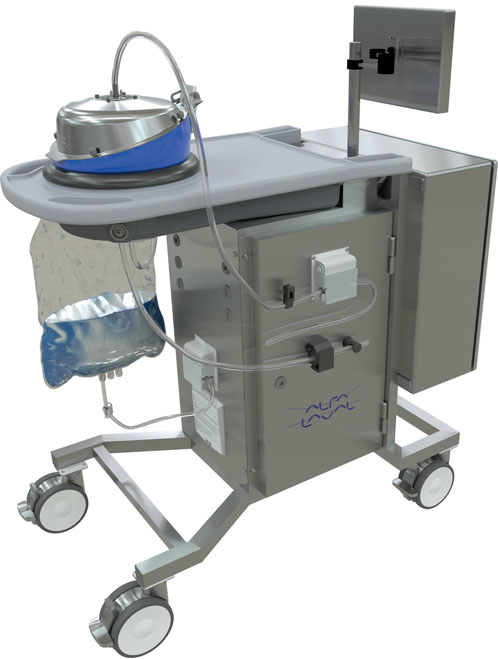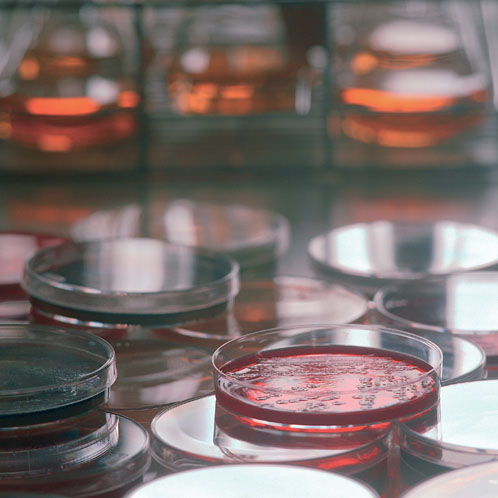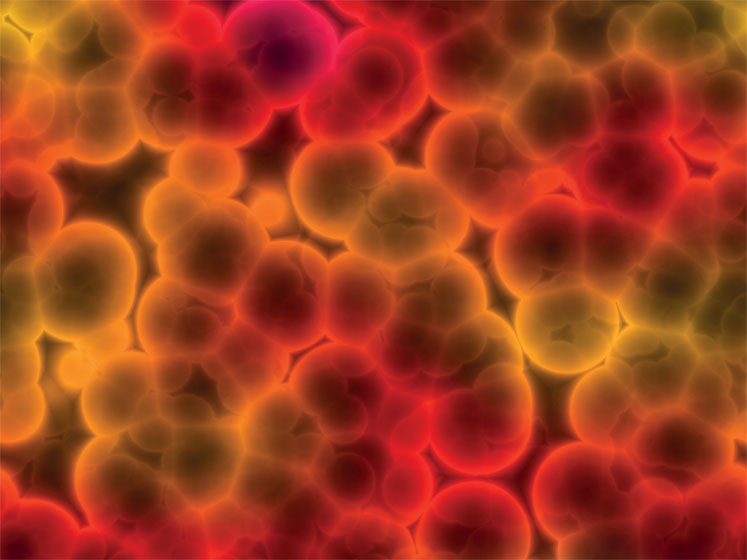With this is mind, Ian Forrester, Business Unit Manager for Separation and Food Systems at Alfa Laval, discusses how new developments in culture separation technology can help to alleviate demand.
The ability to grow and harvest cell cultures outside of the body is one of the most exciting developments in biological science to date.
The potential applications for such a process are enormous, ranging from stem cell self-renewal, the production of animal-free meat and dairy products, and — most pertinent to the pharmaceutical industry — the manufacture of vaccines.
There are currently multiple techniques used to perform culture separation, including microfiltration, depth filtration and centrifugation, with the latter growing to be the industry standard.
This process accelerates natural sedimentation that would occur by spinning the cell culture in a centrifuge, with the density difference between solids and the surrounding fluid causing separation to occur.
The excess fluid is discharged and the operator is left with an isolated cell culture from which they can harvest the vital proteins required for vaccine production.

At present, this method is used to create vaccines for polio, measles, mumps, rubella and chickenpox. These diseases, many of which were once deadly, have been all but nullified thanks to the advent of culture harvesting techniques. A such, the importance of cell harvesting to modern medicine is abundantly clear.
COVID’s impact
What’s more, its importance only continues to grow amid the recent pandemic. From 2020 and into 2021, COVID-19 has affected hundreds of countries across the world and has undoubtedly been the modern medical industry’s most extreme challenge to date.
Although the world’s medical industries are no stranger to using vaccines to combat disease, never before have they needed to produce so many in such a short space of time.
The increase in demand caused by the pandemic has thrust the inefficiencies of current culture harvesting technology into the spotlight and suggested that there may be a more productive way forward for the nation’s laboratories.
Limitations of current technology
Despite culture separation’s significance to the medical industry, current technology is subject to a number of drawbacks that impair the efficiency of the harvesting process.
Until now, centrifuges have been available in two formats: those that use stainless-steel discs that can be sterilised and used again, and those made of single-use plastic.
Although each can claim to mitigate the shortcomings of the other, neither are capable of “true” efficiency, as each design comes with its own limitations.
Stainless-steel centrifuges, once the industry standard, boast reusable metal discs that slot into the centrifuge bowl. In between cycles, the discs are sterilised to allow them to be used again, unlike their plastic counterparts.
However, disinfecting the discs can often prove to be a time-consuming operation in itself, while also incurring additional expenses for the chemicals used to do so.
In fact, the amount of chemicals consumed by frequent sterilisation actually renders stainless-steel centrifuges less environmentally friendly than plastic ones, despite their reusable nature.

Single-use plastic centrifuges circumvent the need for sterilisation by using slot-in recyclable plastic discs and inserts that are disposed of once used, but do so at a trade-off.
Single-use models have, until now, only been available in batch-processing formats, sacrificing the ability to operate continually as stainless-steel variants do.
For the operator, this means that excess fluids are not discharged throughout, necessitating intermittent access to the internal bowl for manual disposal. In a laboratory setting, this can be similarly harmful to productivity as it requires an operator to be available to discard the waste material.
What advantages are gained by bypassing the need for sterilisation are offset by the absence of continual operation, rendering the impact on overall productivity functionally identical to its metal counterpart.
Filtration systems offer an alternative to using a centrifuge, but are becoming increasingly ineffective at separating cell cultures. The advent of high titres, increased cell densities and process intensification has created material that is harder to process for both traditional centrifuges and filtration solutions. The result is decreasing yields, poor separation and cell rupture when attempting to process newer cell fermentations.
The dangers of lysis
Moreover, the current standard of culture separators on the market — encompassing both formats — cannot guarantee the consistent and/or gentle treatment of cell cultures. Cells, by their very nature, are extremely delicate and fragile organisms, and so must be treated with the utmost care lest the cell wall or membrane rupture.
This process, known as lysis, results in the disintegration of the cell and the loss of the valuable proteins inside, meaning that cultures cannot be reprocessed to reap further useful material.
The release of additional impurities into the valuable liquid also vastly complicates the effort to isolate the target proteins. Understandably, when accelerating cells to high speeds using a centrifuge, there is an accepted risk of this happening, but it is one that current technology does not take effective steps to minimise.
Resultantly, culture yields are often harmed by the sporadic occurrence of lysis, once again hampering the overall efficiency of the culture harvesting process.
Advantages of new technology
When the shortcomings of stainless-steel and single-use plastic centrifuges are set out, it is clear that neither format is fit to bear the burden of the medical industry’s demand.
Both models possess traits that limit operational time for pharmaceutical manufacturers and neither can guarantee that lysis will not occasionally occur during the process of acceleration, meaning that overall production rates are harmed in turn.
With current technology no longer up to standard, companies such as Alfa Laval have recognised the need to develop solutions that combine the benefits of both reusable and single-use formats. The result of this development is the CultureOne, the industry’s first premium separator system for single-use cell culture processing.
One of the key limitations of stainless-steel centrifuges is the need to routinely sterilise the interior metal bowl, so developing solutions with single-use parts has been a priority.
This has been done by way of presterilised polypropylene parts, such as Alfa Laval’s UniDisc and Spinsert technology. Innovations such as this allow operators to maximise uptime on their processes by simply disposing of the 100% recyclable disc stack and insert after use, with the slot-in housing system allowing new discs to be quickly inserted so the centrifuge can begin its next cycle.
Advancing single-use centrifuge technology
However, new technology also makes one crucial improvement to existing single-use platforms. Until now, centrifuges that utilise recyclable plastic components have only been available in batch-processing formats, requiring intermittent access from the operator to discharge waste material.
By combining the single-use nature of plastic systems with the ability to discharge fluids during operation, modern centrifuges are able to operate continually without any human interaction.
The integration of features such as the CultureOne’s TopStream functionality have been crucial to this development, allowing newer centrifuges to dispose of waste material with the effectiveness of high-end metal models.

Modern culture separators are also able to ensure more careful treatment of material within the central bowl, meaning disintegration of cell cultures owing to lysis is a rare occurrence.
For example, the CultureOne’s centrifuge rotates at speeds of up to 5000 RPM during each cycle, with internal contents experiencing up to 12,000 x g of force.
This velocity results in a short settling distance and large separation area, in turn achieving consistently high biomass yields of up to 98% each cycle. Crucially, this process also allows cell cultures to be recovered intact, meaning they can be reprocessed if desired.
The effects of these enhancements on overall productivity are measurable. Most notably, the combination of continual operation and slot-in presterilised components such as disc stacks or centrifuge bowls that allow for greatly increased uptime on the centrifugation process without the need for manual ejection or sterilisation between cycles.
Moreover, without the fear of lysis, operators can get the most use out their cell cultures by reprocessing them while achieving consistently high protein yields from their material each cycle. By minimising downtime and maximising yields, new technology, such as the CultureOne, can achieve the levels of productivity demanded by a modern laboratory environment.
Looking forward
The pandemic has simultaneously placed strain on current culture harvesting technology and highlighted its shortcomings. The operation of both stainless-steel and single-use culture separators is hampered by intermittent downtime, meaning that overall lab productivity is harmed in turn.
As such, we should look towards new technologies that are capable of more efficient performance and increased output to effectively meet burgeoning industry demand.
